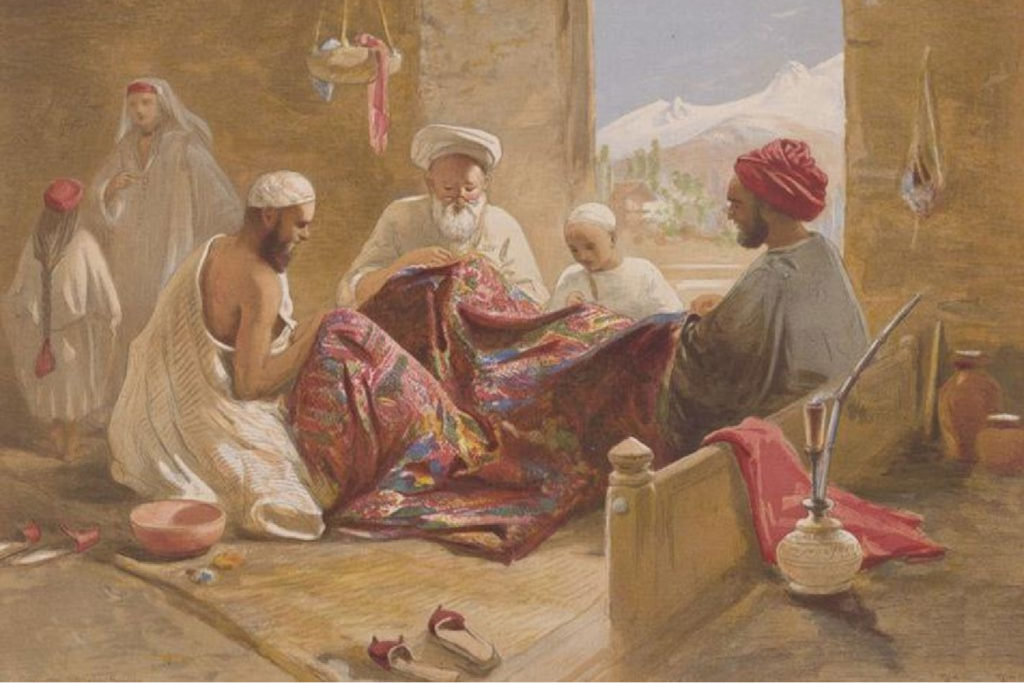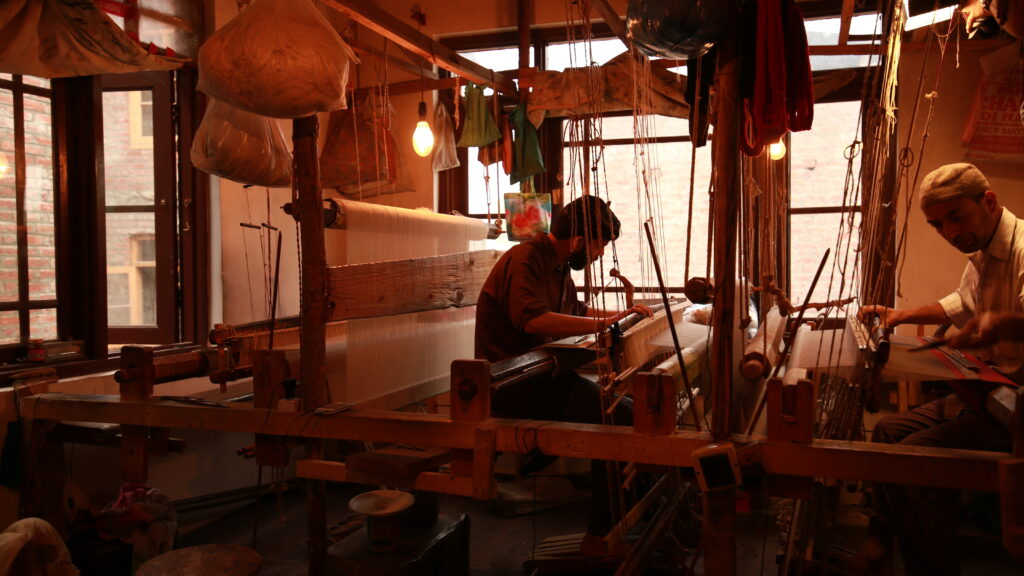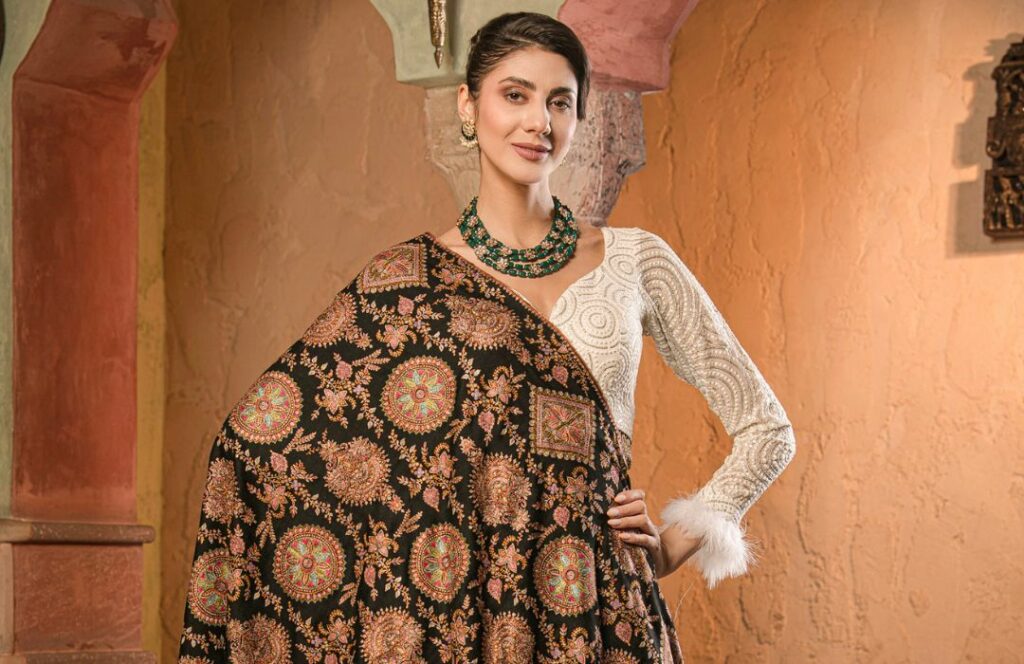Pashmina has carried deep cultural and symbolic meanings for centuries. It is famous for its unparalleled softness and fine craftsmanship. But what does the Pashmina symbolize beyond its material beauty? With its source being the fine Cashmere wool of Changthangi goats, it finds associations with status, heritage, and timeless fashion. The most skillful artisans of Kashmir have crafted it since its inception in the 15th century.
Originating from the Himalayan mountains, Cashmere has been worn by royalty and nobility for centuries. It has served as a symbol of wealth, grace, and tradition. Artisans in Kashmir perfected the art of transforming delicate Cashmere wool into luxurious shawls, scarves, and wraps. Today, Pashmina has transcended its cultural roots to gain global recognition. It has become a fashion staple loved by celebrities, designers, and style enthusiasts across the world.
So, let's explore what the Pashmina symbolizes on multiple levels. Let's delve into its significance in cultural heritage, luxury fashion, and sustainable craftsmanship. We will uncover how this fine art stands as a symbol of elegance, tradition, and eco-friendly luxury, while also representing durability and ethical production in the fashion world.
Cultural Heritage and Tradition

Pashmina, the prized art, originating from the Himalayan regions, has deep cultural roots in both Kashmiri and Ladakhi societies. Its legacy stretches back centuries, woven into the social and cultural fabric of these regions. But what does the Pashmina symbolize in the context of heritage and tradition? It’s not merely a luxurious shawl but an emblem of the rich history, prestige, and honor that these communities uphold.
Kashmiri and Ladakhi Culture
In Kashmiri and Ladakhi cultures, Pashmina shawls are more than just functional clothing. They are a part of the daily lives and traditional attire of the people. The art of making shawls has been passed down through generations of artisans, who have perfected the skill of transforming the finest Cashmere wool into exquisite shawls. This delicate craft, which involves hand-combing, spinning, and weaving, is regarded as a form of high art.
For centuries, Pashmina shawls have been an essential part of both Kashmiri and Ladakhi wardrobes. In Ladakh, high-altitude regions offer the perfect conditions for the Changthangi goats to grow the fine undercoat that provides the raw material for Pashmina. Kashmiri weavers, renowned for their precision and artistic flair, then turn this wool into something truly special. Historically, Pashmina has adorned people in the cold Himalayan climate while also serving as a marker of social standing.
In royal and aristocratic households, wearing a Pashmina shawl was a way to showcase elegance and nobility. Beyond their practicality, the beauty and rarity of these shawls made them a treasured possession, handed down from generation to generation. To own and wear a Pashmina shawl was a symbol of wealth and refinement, distinguishing the wearer as someone of status and class. Even today, in many Kashmiri households, Pashmina remains an heirloom passed through families, keeping its cultural and emotional value intact.
Historical Symbol of Prestige
Throughout history, Pashmina has symbolized wealth, prestige, and luxury, a fabric reserved for royalty, nobility, and the elite. During the Mughal period, it became an essential element in the courtly attire of emperors, princes, and noblemen. The Mughal emperors were particularly fond of Pashmina. Artisans would often intricately weave and embellish them with gold or silver threads to reflect their grandeur.
One notable historical figure known for his love of Pashmina was Emperor Akbar. He made this art form an indispensable part of Mughal court fashion. The shawls were often given as royal gifts and traded among aristocrats as tokens of goodwill, further elevating their prestige. The luxurious nature of Pashmina also made it a coveted item in European courts. In these courts, kings introduced Pashmina through trade in the 18th and 19th centuries.
In many aristocratic households, Pashmina became a valuable asset. It was often included in a bride's trousseau as a symbol of good fortune and prosperity. Brides in both Kashmiri and Ladakhi families would receive Pashmina shawls as part of their wedding gifts. The finest pieces represented not only the family’s wealth but also its respect for tradition and craftsmanship. To gift these shawls to a bride was to provide her with warmth, comfort, and a piece of heritage that she could carry forward.
A Gift of Honor and Respect
In various cultures, people consider Pashmina a token of honor, respect, and affection. It is more than just a material gift. In fact, it represents the giver’s appreciation for the recipient’s value, a gesture laden with cultural significance. In weddings, religious ceremonies, or significant life events, gifting a Pashmina shawl symbolizes good luck, respect, and warmth, reflecting the care and love of the giver.
For instance, during weddings, hosts often present Pashmina shawls to close family members as a way of showing respect. In many Indian households, guests of honor are welcomed with a Pashmina shawl draped over their shoulders as a sign of warmth and respect. Similarly, during religious and cultural festivals, it serves as a gift that transcends material value, embodying deep personal connections and reverence.
Moreover, as Pashmina gained global popularity, its role as a gift of honor extended beyond its traditional regions. In diplomatic and state exchanges, Pashmina shawls are often presented as gifts from dignitaries, symbolizing respect between nations. This act reinforces the idea that this shawl is not merely a product of fine craftsmanship but a cultural artifact of deep significance, symbolizing history, respect, and shared values across borders.
In essence, Pashmina remains an enduring symbol of cultural heritage, tradition, and social prestige. From the artisans who painstakingly create these masterpieces to the wearers who treasure them, the shawls encapsulate generations of history, love, and respect. Its place in weddings, ceremonies, and royal courts attests to its timeless significance. What does the Pashmina symbolize? It represents not just a luxurious fabric but a living heritage - rich with stories, emotions, and the timeless values of honor and tradition.
Pashmina as a Symbol of Luxury
Pashmina, often regarded as the pinnacle of elegance and sophistication, has long held a special place in the world of luxury fabrics. It represents not only comfort and warmth but also exclusivity and status, capturing the attention of discerning fashion enthusiasts and global elites. What does the Pashmina symbolize? It stands as an embodiment of timeless luxury, handcrafted artistry, and cultural heritage, making it a coveted piece in wardrobes across the globe.
Timeless Elegance and Exclusivity

Pashmina is synonymous with luxury, and for good reason. The unparalleled softness and warmth it offers make it a material unlike any other. The wool from which artisans create Pashmina comes from the fine undercoat of the Changthangi goat. It is found in the harsh, high-altitude regions of Ladakh. This specific type of Cashmere wool is among the finest and most delicate in the world. Hence, it provides Pashmina with its signature softness that one can feel immediately upon touch.
Creating a Pashmina shawl or scarf is not a process that one can rush. It requires time, patience, and expert craftsmanship. Skilled artisans carry each step, from hand-combing the raw wool to spinning it into threads and finally weaving it into a shawl, meticulously. They have inherited these techniques through generations. This labor-intensive process is part of what elevates it to the realm of exclusivity. The amount of time and effort that goes into creating a single shawl, often taking months to complete, makes Pashmina a rare and highly sought-after luxury item.
The symbolic association between Pashmina and exclusivity comes not only from its fine materials and craftsmanship but also from its limited availability. The production of genuine Pashmina is geographically restricted. This is because the Changthangi goats only thrive in the cold, harsh climates of Ladakh. As a result, the wool is rare and precious, further driving the demand for authentic Pashmina products. Owning a piece of Pashmina is like owning a part of an ancient tradition. Its timeless elegance has made it a symbol of wealth, refinement, and sophisticated taste.
Global Recognition as a Luxury Item
Pashmina has deep cultural roots in Kashmir and Ladakh. Yet, it has transcended these origins to become a globally recognized symbol of luxury. Over the past few decades, Pashmina has entered the world of high fashion. Designers and fashion icons have embraced it as a quintessential luxury accessory now. Celebrities, royalty, and influential fashion figures alike have been spotted wearing Pashmina shawls, elevating its status on a global scale.
Designers have incorporated Pashmina into their collections, not just as a traditional accessory but as a versatile and timeless fashion piece. Whether draped over evening gowns at red-carpet events or styled with casual outfits for everyday wear, it adds a layer of sophistication and elegance to any ensemble. Its lightweight warmth and soft texture make it an ideal choice for those looking to blend style with comfort.
Fashion icons such as Audrey Hepburn, Kate Middleton, and Princess Diana have all worn Pashmina shawls. This has helped to cement its reputation as a luxury item. Their association with Pashmina has only added to its appeal. This is because these individuals have been symbols of grace, class, and style. By choosing to wear Pashmina, they have not only endorsed the fabric but also the craftsmanship and cultural heritage behind it. In this way, Pashmina’s global recognition as a luxury item goes beyond fashion—it becomes a statement of taste and sophistication.
Handmade Craftsmanship
What sets Pashmina apart from other luxury fabrics is not just its fine material but the extraordinary craftsmanship involved in its production. Each genuine Pashmina product is handmade. Artisans dedicate weeks or even months to creating a single shawl. This manual process begins with hand-combing the wool from the Changthangi goats. A careful separation of the fine undercoat from the coarser outer layers is done. Artisans then spin the wool by hand into fine threads, a delicate process that requires precision and expertise to ensure the fibers remain intact and soft.
The weaving of Pashmina is a true art form. Artisans, often working on traditional looms, weave the threads together to create the shawl’s intricate patterns and designs. Many Pashmina shawls are further embellished with hand-embroidered details, adding another layer of craftsmanship to the piece. These intricate designs often reflect cultural motifs and traditional symbols, making each shawl unique and deeply connected to the artisan’s heritage.
This dedication to traditional, handmade techniques elevates Pashmina from being just another fabric to a symbol of fine craftsmanship. In an age of mass production and fast fashion, the time and effort invested in each Pashmina shawl highlight its exclusivity and cultural significance. The artisans who create Pashmina have mastered their craft over generations, and by owning a Pashmina, individuals are supporting these traditional skills and keeping this ancient art alive.
So, what does the Pashmina symbolize? It stands as an enduring symbol of luxury, heritage, and craftsmanship. Its timeless elegance, global appeal, and commitment to handmade quality have earned it a special place in the world of fashion. Whether worn as a statement piece or passed down as a cherished heirloom, Pashmina remains a symbol of sophistication, tradition, and the ultimate in luxurious living.
Pashmina and Sustainability

In today’s world, environmental consciousness plays an increasingly important role in consumer choices. Hence, Pashmina stands as a powerful symbol of sustainability and ethical fashion. This luxurious art, revered for its beauty and craftsmanship, embodies a way of life that values eco-friendly practices, supports local artisans, and emphasizes quality over mass production. So, what does the Pashmina symbolize in a modern context? It represents a commitment to sustainability, slow fashion, and the preservation of cultural heritage. Hence, it is an ideal choice for those who prioritize responsible luxury.
Ethical and Sustainable Fashion
As the world shifts toward more ethical and environmentally friendly practices, Pashmina has gained recognition for its sustainable production methods. The creation of authentic Pashmina products has roots in centuries-old techniques that prioritize natural processes and materials. Synthetic fabrics rely on harmful chemicals and industrial-scale production. But, producers create it using low-impact, environmentally safe practices that align perfectly with modern principles of sustainable fashion.
The wool used in Pashmina comes from the undercoat of the Changthangi goats, native to the high-altitude regions of Ladakh. These goats are not harmed in the process of harvesting their wool, as the fibers are carefully hand-combed during their natural shedding season. This humane and eco-friendly method ensures that the goats continue to thrive in their environment while providing high-quality wool.
Furthermore, Pashmina production often utilizes natural, low-impact dyes. The use of toxic chemicals that can pollute water sources and harm ecosystems is avoided. The dyeing process is done with great care, often using plant-based or mineral-based dyes, contributing to the preservation of the environment. The hand-spinning and hand-weaving techniques used by artisans also require minimal energy, further reducing the carbon footprint of Pashmina production.
By choosing Pashmina, consumers are not only investing in a luxurious, high-quality product but also supporting sustainable practices. In an industry often criticized for its environmental harm, Pashmina represents a more ethical approach to fashion. The makers prioritize the well-being of the planet and future generations.
Supporting Local Artisans
Pashmina is more than just a beautiful fabric; it symbolizes the livelihoods of the skilled artisans who create it. For centuries, the art of making has come down through generations of weavers in Kashmir and Ladakh. These regions have deep connections with this craft. When consumers purchase authentic Pashmina, they are directly supporting these artisans and their families, helping to sustain local economies and preserve a unique cultural heritage.
The traditional methods used to produce Pashmina are highly labor-intensive, requiring hours of meticulous work from skilled hands. From hand-combing the wool to hand-spinning the threads and weaving the final product, each step involves careful craftsmanship. This not only adds to the beauty and quality of Pashmina shawls but also ensures that people value and preserve the skills of these artisans.
In an era where mass production often leads to the exploitation of workers in developing countries, Pashmina offers an alternative that prioritizes fair wages and ethical working conditions. Artisans who create Pashmina are often part of small, family-run businesses or cooperatives that ensure fair compensation for their labor. This makes Pashmina not only a symbol of luxury but also of responsible consumerism.
When buyers choose Pashmina, they are investing in a product that supports the preservation of ancient crafts and promotes the well-being of communities that rely on these traditions for their livelihoods. This conscious choice is an important part of the broader movement toward ethical, fair-trade fashion that values people as much as the product itself.
Slow Fashion and Longevity
In stark contrast to the fast fashion industry, which produces cheaply made, short-lived garments in bulk, Pashmina represents the principles of "slow fashion." Slow fashion emphasizes quality, craftsmanship, and sustainability over quantity and disposability. Each shawl, scarf, or wrap is carefully crafted by hand, often taking weeks or even months to complete. This slow, deliberate process ensures that makers create each piece with the utmost care and attention to detail. It results in a product that is not only beautiful but also built to last.
The longevity of Pashmina products makes them a wise investment for consumers who value durability and timeless style. Unlike fast fashion items, which quickly fall out of style or wear out after a few uses, a well-made Pashmina shawl can last for years - often becoming a cherished heirloom passed down through generations. Its natural fibers retain their softness and warmth over time, while the craftsmanship ensures that the fabric remains resilient and resistant to wear.
Pashmina’s durability also makes it a more sustainable option compared to cheaply made, disposable clothing. By choosing Pashmina, consumers are rejecting the wastefulness of fast fashion and embracing a philosophy of quality over quantity. A single Pashmina shawl can be worn and enjoyed for many years, reducing the need for frequent replacements and minimizing the environmental impact associated with constant consumption.
In addition to its longevity, Pashmina’s timeless elegance ensures that it never goes out of style. Whether worn as a formal accessory or a casual wrap, Pashmina complements a wide range of outfits and occasions, making it a versatile and enduring addition to any wardrobe.
Symbol of Comfort and Practicality

In addition to its luxurious reputation, Pashmina stands as a symbol of comfort and practicality. While it is often admired for its elegance and exclusivity, Pashmina also offers remarkable functionality. This makes it a versatile choice for many. So, What does the Pashmina symbolize? Beyond luxury, it represents a seamless blend of comfort, warmth, and universal appeal. It has become a wardrobe staple for various occasions and climates.
Lightweight Warmth and Versatility
One of the standout qualities of Pashmina is its ability to provide warmth without the bulk, unlike woolen fabrics. The fine fibers from the undercoat of the Changthangi goat, native to the Himalayan region, are what give Pashmina its extraordinary softness and insulation properties. Unlike thicker, heavier woolen garments, Pashmina shawls and scarves are super lightweight. This makes them comfortable to wear for extended periods without feeling cumbersome or restrictive.
This lightweight warmth makes it ideal for a variety of climates. In colder weather, it acts as an excellent insulator. It traps heat and provides cozy warmth, whether draped over the shoulders or wrapped snugly around the neck. In milder climates, Pashmina still serves as a practical accessory, offering just enough coverage to ward off a light chill without overheating the wearer. This adaptability to different temperatures makes it a practical item for both formal and casual settings.
Its versatility extends beyond climate suitability. One can wear it in many different ways, from a sophisticated wrap-around evening attire to a casual scarf with everyday outfits. Its timeless design means it complements both modern and traditional styles, allowing it to be effortlessly integrated into any wardrobe. This combination of warmth, comfort, and style makes Pashmina much more than just a luxury piece; it is a functional accessory that enhances both comfort and elegance in any situation.
Universal Appeal
Pashmina's appeal doesn't confine itself to a specific demographic or cultural group. It transcends age, gender, and background, symbolizing a universally loved and cherished accessory. Whether worn by young adults seeking stylish additions to their outfits, or by older generations looking for warmth and comfort, Pashmina has the ability to suit every individual's needs.
For men, it serves as an elegant scarf or wrap. It adds a touch of sophistication to formal attire or providing warmth in more casual settings. Women, on the other hand, often wear Pashmina in a variety of creative ways. From draping it over their shoulders to styling it as a hijab or scarf, women style it in unique ways. Even children can enjoy the softness and warmth that Pashmina offers, further emphasizing its broad, cross-generational appeal.
Culturally, Pashmina holds significance across different parts of the world. It has deep roots in Kashmiri and Ladakhi traditions. But over time, it has gained popularity worldwide, becoming a symbol of both style and practicality. This global appeal highlights the fabric’s ability to be appreciated and used by people from various cultural backgrounds, reinforcing its role as a symbol of comfort and universal elegance.
Also read: Altogether Luxury: Mystique of Fine Cashmere wool
Conclusion
Throughout its rich history, Pashmina has come to symbolize much more than a luxurious art form. It represents the essence of luxury, with its softness, warmth, and exclusivity. The art has deep ties with cultural heritage, especially in the regions of Kashmir and Ladakh, where it has been a part of royal attire and significant life events for centuries. It is also a symbol of craftsmanship, as the creation of each shawl or scarf involves painstaking handwork by skilled artisans. Its role in sustainability is equally vital, reflecting ethical fashion practices and support for local economies. Moreover, Pashmina embodies comfort and practicality, combining warmth with versatility, making it a go-to accessory for all ages and occasions. Finally, Pashmina holds emotional value, often given as gifts of respect, love, and honor.
Pashmina is not just a material possession; it is a multi-faceted symbol that resonates on different levels for different people. For some, it represents elegance and timeless fashion; for others, it’s a connection to tradition and cultural identity. It is also an emblem of sustainability, standing in contrast to fast fashion trends with its slow, handcrafted production methods. On a personal level, Pashmina reflects individual style and serves as a meaningful, cherished accessory that can be passed down through generations. The richness of its symbolism makes it a truly unique and valuable item.